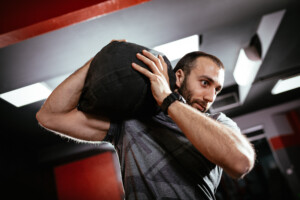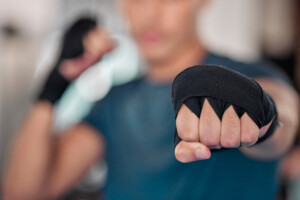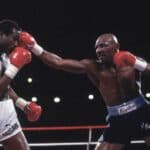MMA is a brutal and demanding sport. Not only do fighters have to train hard to be physically prepared for their fights, but they also have to ensure they are within the weight limit for their division. This can sometimes mean cutting a lot of weight in a short amount of time. So, how do they do it? In this article, we’ll look at how fighters cut weight while maintaining their strength and energy levels.
Why Do UFC Fighters Cut Weight?
There are two main reasons why fighters cut weight. The first is for competitive advantage. By fighting in a lower weight class, fighters put themselves at a size “advantage” over their opponents. This can be a significant advantage, especially if the fighter has experience cutting weight and knows how to do it correctly.
However, this advantage is often mitigated by the weight cut itself, which can sap a fighter’s energy and strength. The fact that both fighters cut weight and, on fight night, end up heavier than they were at the weigh-ins often negates any size advantage. Some fighters do have the size advantage since they are so good at cutting weight. Fighters such as Anthony “Rumble” Johnson, Paulo Costa, and Vitor Belfort have all been known to successfully compete at much lower weight classes than their natural bodyweight.
The second reason fighters cut weight is because they want to fight in a specific weight class. For example, if a fighter wants to fight in the welterweight division (170 lbs), but they currently walk around at 200 lbs, they will have to cut 30 lbs of water weight. While this may seem like a lot, it’s actually not uncommon for fighters to cut 20-30 lbs of water weight before a fight.
How Do UFC Fighters Cut Weight Before a Fight?
Most fighters will use a combination of saunas, steam rooms, and Epsom salt baths to sweat out water weight in the days leading up to their weigh-in. On the day of the weigh-in, many fighters will not drink any fluid to make weight.
Once they step on the scale and make weight, they will immediately start rehydrating themselves. This is done by drinking fluids (usually water or sports drinks) and eating foods that are high in electrolytes (such as bananas, avocados, and sweet potatoes).
Maintaining a Caloric Deficit

However, the weight-cutting process starts much earlier than fight week. Fighters will start out by going into a caloric deficit a few weeks before the fight. This means eating fewer calories than they are burning each day.
By doing this, fighters will slowly start to lose body fat. The goal is to get as close to their weight limit as possible while still having some body fat to lose in the final week. This way, they can maximize the amount of weight they can lose in the final week through water weight loss.
Increased Cardio Leading up to the Fight
Fighters will also increase their cardio in the weeks leading up to the fight. This helps them burn more calories and lose body fat.
In the final week, fighters will start to taper their training. This means reducing the amount of cardio they are doing and cutting back on their calories. The goal is to minimize the amount of muscle they are losing while still being in a caloric deficit.
Taking Diuretics to Increase Water Removal
Some fighters will take diuretics to help them lose water weight. These are drugs that help increase the amount of urine output. They can be very effective, but they also come with some risks.
For example, diuretics can cause dehydration, which can lead to cramping and other problems. They can also cause electrolyte imbalances, which can be dangerous.
Using Saunas And Sauna Suits

Many fighters will use saunas and sauna suits to help them lose water weight. Sauna suits are especially popular because they allow fighters to sweat without losing water through urination.
Fighters will often wear sauna suits while doing cardio or working out. This helps them lose a lot of water weight in a short period of time.
Epsom Salt Baths for Cutting Weight
Epsom salt baths are another popular way for fighters to lose water weight. Epsom salt is a type of magnesium sulfate that can be dissolved in water. When fighters soak in an Epsom salt bath, they sweat out a lot of water weight.
Fighters will often take multiple Epsom salt baths in the days leading up to their weigh-in. This helps them lose a lot of water weight quickly.
How Much Weight Can MMA Fighters Cut?
Fighters can typically safely lose up to 20% of their body weight through the weight-cutting process. However, some fighters have been known to lose more than that.
For example, UFC fighter Anthony Johnson has been known to cut over 40 lbs of weight for his fights. While this is safe for him, it’s not something that most fighters should try to do.
It’s important to note that the more weight a fighter cuts, the greater the risk of health problems. This is why it’s important for fighters to work with a nutritionist or other expert when cutting weight.
It’s not uncommon for fighters to lose 5 – 10% of their body weight in the 24 hours leading up to the weigh-in. On the day of the weigh-in, fighters will often strip naked and step on the scale multiple times to make sure they are within the weight limit.
Is Weight Cutting Dangerous?
Weight cutting is definitely dangerous and can even be deadly if done incorrectly. Dehydration steals electrolytes from your body which can lead to cramping, fatigue, and dizziness. In extreme cases, dehydration can even lead to renal failure and death. That’s why it’s so important for fighters to rehydrate properly after cutting weight. Many fights have been canceled due to one or both fighters being too dehydrated to compete safely.
Weight cutting is a very energy-intensive process. Not only does it sap your strength and energy, but it also puts a lot of stress on your body. This can lead to injuries, dehydration, and a whole host of other problems.
It is not uncommon to see fighters pale, unenergetic, and too skinny for their frame when they make weight. This is because they have lost so much water, weight, and muscle that their bodies are in a state of near shock.
How To Safely Rehydrate?
After cutting weight, it is essential that fighters rehydrate properly. They should drink plenty of fluids and eat foods that are high in electrolytes. Some fighters will even get IV to help them rehydrate quickly.
Fighters should also avoid drinking alcohol and caffeine after their fight since their body will be dehydrated, and these substances will further dehydrate them.
It is also important for fighters to give their bodies time to recover after cutting weight. They should avoid strenuous activity and take it easy for a couple of days after their fight, which most fighters do.
Hydration Tests
There have been some new ways of controlling the “natural” weight of fighters so they couldn’t weight cut as much. The ONE Championship has been using hydration tests to see what is the “safe” weight for each fighter to battle at. Dramatic weight fluctuations are against their policy.
These work on the principle of using an instrument that measures the gravity of the urine. The instrument tests how much solutes are in the fighter’s urine, and from that, an estimation of the fighter’s hydration levels can be made. ONE Championship is also more lenient when it comes to “missing” weight.
Conclusion
Cutting weight is an essential part of being a successful MMA fighter. However, it is also a very demanding process that requires careful planning and execution. It is often a controversial and dangerous practice in mixed martial arts. While some fighters do it for competitive advantage, others do it because they want to fight in a specific weight class. Regardless of the reason, all fighters need to be aware of the risks associated with dehydrating their bodies and take steps to ensure that they are safe when they step into the cage.












